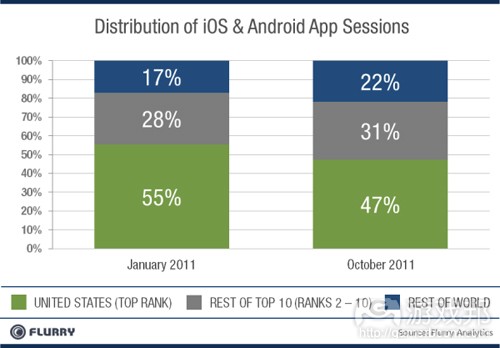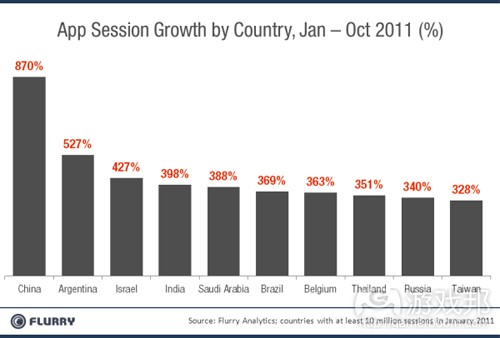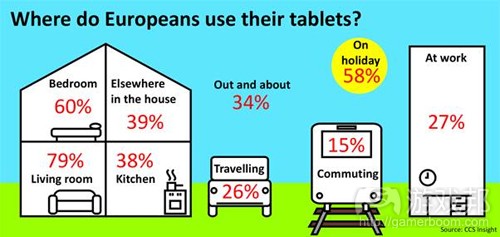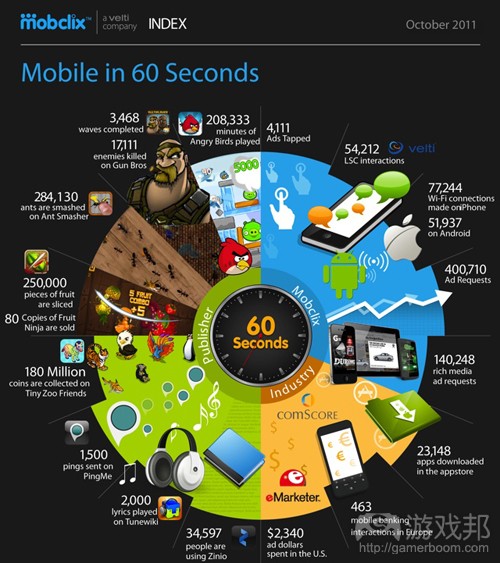每日观察:关注中国应用程序活跃度居世界第二(11.3)
1)据移动分析公司Flurry十月份数据显示(游戏邦注:Flurry分析结果采自其SDK绑定的12万款手机游戏及应用),中国应用程序访问率有所上升,应用活跃度排名仅次于美国。最值得注意的是,中国应用活跃度在今年初居于第十位。
如下图所示,绿色区域代表美国应用访问量所占比例,该国仍领先于世界其他国家。尽管10月份美国应用访问量比1月份双倍增长,但所占市场份额在这一时期已从55%下降至47%,这表明其他国家的应用访问量正迅速增长。
其他几个排在前十名国家(包括英国、加拿大、澳大利亚、法国、德国、日本、印度尼西亚、韩国和中国)的应用访问量比1月份增加了2.7倍,所占份额已从28%上升至31%。Flurry工具所追踪的世界其他217个国家或地区的应用访问量所占份额已从17%上升至22%。
从以下的世界前十名国家图表中可以看出,中国在2011年1月至10月的应用访问量增长了870%,超过前100名国家增长率的4倍(前100名国家增长率平均超过200%)。
以下图表显示的是2011年第二至第五名国家应用访问率发展情况(为更好说明情况,已将美国排除在外),中国在今年1月份的应用访问量所占比例仅为1.8%,到4月份上升至第五名,占总体比例的2.7%,6月份超过英国成为第二名,应用访问量占5.4%,10月末增长至7.3%。而美国所占份额已下降至47%,假如中美两国应用访问量保持目前发展状态,中国有可能在2013年赶上美国,届时两国所占比例将为23%左右。
Flurry还通过其AppCircle推广平台观察了各国新款应用程序下载情况(游戏邦注:这里指各国用户通过AppCircle广告下载的新应用程序),中国在今年初的AppCircle下载量仅占1.2%的比例,但10月份攀升至12%;美国仍领先于其他国家和地区,所占份额为57%;台湾地区占4%,英国与加拿大各占3%;澳大利亚与香港各占2%,其他国家和地区占17%。
2)芬兰开发商Rovio日前宣布《愤怒的小鸟》下载量已突破5亿次(5月份时达2亿次下载量),该公司首席营销官Peter Vesterbacka表示,《愤怒的小鸟》的意义已经超过了游戏范畴,其周边产品在6月份已售出300万个钥匙扣和3000万件T恤。
3)瑞士手机社交游戏开发商Gbanga最近表示,旗下混合现实地理定位游戏《Gbanga Famiglia》发布6个月以来,每10名玩家中就有一者曾购买游戏虚拟商品,还有一小部分铁杆玩家甚至会购买1600件特制道具。
该游戏最便宜和热销的道具是售价99美分的Police Megaphones,但占据最大营收比例的却是9.99美元的Respec‘Da Bass。
从总体上看,该游戏平均每名用户的消费金额是14美元。
该公司首席执行官Matthias Sala表示,他们打算通过未来数周将问世的3.0版本推出更多道具,但也会兼顾付费与非付费玩家的需求,并称游戏虚拟商品通过其链接的双周迷你小游戏的推广,获得了更大的销量。
4)英国手机比较网站GodMobilePhone.co.uk最近调查发现,用户主要是因为无聊为消遣时间而下载应用程序。
44%调查对象称自己是无聊才下载应用;
31%因好友推荐而下载应用;
29%是看到应用商店推荐的“每周应用”版本而采取行动;
21%因电视节目或其他媒体的推广而下载应用;
15%是感觉某应用看起来“很有趣”而点击下载。
调查还发现,五分之一的智能手机用户每月至少支出20英磅用于下载应用程序,35%每月投入10英磅,25%用户仅下载免费产品。
59%受访者认为自己在应用程序上“花了太多钱”,19%认为自己“还能再花点钱”,22%表示“不确定”或者认为自己在其中消费的数额“并无不妥”。
5)法国游戏公司育碧日前宣布收购游戏开发商RedLynx(代表作包括赛车游戏《Trials》以及iOS游戏《DrawRace 2》)。
RedLynx推出的《DrawRace 2》曾是美国和欧洲最热销App Store游戏之一。这是育碧在休闲游戏领域的最近一笔收购交易,在此之前,育碧还收购了Massive Entertainment、Quazal和Owlient。
6)市场调研机构CCS Insight最近报告指出,十之八九的英国平板电脑用户平均每天在该设备上投入时间达2.8小时,79%的用户习惯蜷缩在沙发上使用平板电脑,60%是在卧室中使用平板电脑。
几乎每10个欧洲人中就有4人在洗手间使用平板电脑,甚至有不少人以烹饪应用程序取代了传统的厨艺食谱。
甚至还有58%的用户将平板电脑视为与防晒箱一样必不可少的假期装备。
尽管平板电脑在旅行者中间极受欢迎,但仅有15%的用户会在上下班途中使用平板电脑,原因是这个路途中缺少3G和无线网络服务,所以大家只好用电子阅读器打发时间。
95%以上的英国用户每天至少使用一次平板电脑,11%用户每天在线时间超过5小时。
60%用户以平板电脑打发时间,但仅有7%将其用于商务。
非iPad平板电脑用户平均每天使用设备的时间比iPad用户多30分钟左右,原因是较年轻的用户一般选择更平价的平板电脑使用社交网络等服务。
CSS Insight高级副总裁Martin Garner称,平板电脑提供了一种更便捷更社交的方式,让用户无需转变位置也能上网,它改变了人们的日常生活习惯。但平板电脑制造商需注意,只有平板电脑上的企业应用程序获得极大发展后,该设备才有可能更具商务吸引力。
7)移动数据分析公司Oracle最新报告指出,全球现有69%的移动用户拥有智能手机,57%用户拥有平板电脑或者打算来年购买一部平板电脑;约有半数用户使用手机上网或登录社交网络。
2010年超过50%的机构预测移动设备将在5年内取代照相机、MP3播放器或GPS系统,而结果证明这个趋势比预测更早到来,移动设备已取代了43%的照相机,34%的MP3播放器和24%的GPS系统。
手机应用程序的用户需求最大,55%用户曾下载过一款免费应用,25%曾下载过一款付费应用。
68%用户对移动设备上的个人信息安全表示担忧,还有84%用户情愿去实体店消费也不愿使用手机进行网购。
8)日本游戏发行商Capcom日前发布2012财年上半年(截止9月30日),指出该时期公司手机游戏部门最具盈利性,营收达26亿日元(约3400万美元),同比去年增长89%。
其移动部门营业收入为9.03亿日元(约合1200万美元),同比增长200%,约占公司总体营业收入的32%。
该公司预计其手机游戏业务2012财年总营收将达8000万美元左右,同比去年增长50%,营业收入将达2500万美元左右。
至此,Capcom已成为仅次于EA Mobile、Gameloft的世界第三大手机游戏发行商,其地位超过Glu Mobile、Gamevil和Com2uS。
值得关注的是,该公司移动部门仅有100名成员,而整个公司团队成员是1400人。
Capcom上半年在线游戏营收严重下滑,街机游戏营收则基本与去年持平。从总体上看,公司净销售额为293亿日元(约合3.8亿美元),同比去年下降28%;
净收益为9.06亿日元(约合1200万美元),同比下降49%,据其所称出现这种情况的主要原因是公司在这一时期鲜有重量级的视频游戏问世。
Capcom移动部门现已重新更名为Beeline Interactive,直接听命于日本总部而非美国公司,其手机游戏下载量已超过3000万次,其中以《蓝精灵村庄》表现最为显著;在日本GREE平台发布的《Resident Evil Outbreak Survive》下载量超过100万次。
9)法国手机游戏发行商Gameloft日前宣布公司第三季度销售额达4060万欧元(约合5590万美元),比去年同期拉长17%,智能手机和平板电脑游戏销售额比去年同期增长60%。
智能手机及平板电脑业务已占该公司总收益的34%,去年的这一比例为30%。
据Gameloft所称,公司在亚洲业务获得了显著发展,欧洲、北美之外地区的销售额占43%的比例,欧洲占总销售额的29%,北美占28%。
10)移动广告交易平台Mobclix最近发布的信息图表显示了每60秒内移动领域发生的相关情况(如下图所示):
苹果App Store每60秒的iOS应用下载量达到2.3万次;
《水果忍者》每60秒销量为80份;
用户每60秒在《Tiny Zoo Friends》中收集1.8亿个虚拟货币。(本文为游戏邦/gamerboom.com编译,拒绝任何不保留版权的转载,如需转载请联系:游戏邦)
1)China: The New Mobile App Dragon
by Peter Farago
The chart above compares mobile app sessions tracked by Flurry Analytics in January 2011 and October 2011. Flurry now tracks over 20 billion mobile app sessions per month across more than 120,000 applications. The green area shows the percent of app sessions occurring in the United States, the dominant mobile app market. While the absolute number of sessions in the U.S. has doubled between January and October, its share of total sessions has declined from 55% to 47%. This means that the rest of the world is growing faster. Looking at the balance of the top 10 countries (UK, Canada, Australia, France, Germany, Japan, Indonesia, South Korea and China), this group has increased in collection sessions by 2.7 times between January to October, resulting an increase in total session-share from 28% to 31%. Further, the rest of the world (another 217 countries across which Flurry tracks user sessions), has increased in session-share from 17% to 22%. Among all this growth, there is one country that has caught our attention more than any other.
Meet the Mobile Dragon
You may have heard of China, and its 1.3 billion people. In fact, you most likely associate the country with high volume, affordable manufacturing. However, China is also fast becoming one of the world’s most promising consumer economies. Earlier this year, Bloomberg reported that 2010 foreign direct investment in China rose to a record $106 billion. Included in this are investments by companies such as Wal-Mart, which co-invested over $500 million in online retailing. According to the International Monetary Fund, China has the world’s second largest gross domestic product, behind the U.S., and ahead of Japan, Germany and France. Additionally, the Boston Consulting Group released a report in November 2010 forecasting that the number of middle-income and affluent consumers will almost triple in the next 10 years to 415 million. As it relates to mobile, China has the most cellphone users in the world, with over 950 million users according to statistics released by China’s Ministry of Industry last week.
To understand how this translates into mobile app adoption, Flurry compiled a list of the fastest growing mobile app markets in terms of sessions tracked by our service. We show the chart below.
This chart ranks the top 10 countries, in terms of mobile app session growth, from January 2011 to October 2011. To be included in the analysis, countries had to have generated at least 10 million monthly sessions in January. Inspecting the chart, it’s clear that China’s growth is astronomical. While the top 100 countries are averaging session growth of over 200%, China is delivering more than four times this growth rate, spurred by a massive population voraciously adopting applications.
China Vaults to Second Largest App Economy
With its hyper-growth in app sessions, China has moved up the ranks among the world’s top countries to now occupy the second spot behind the U.S. The graph below charts China’s share of total mobile app sessions per month, relative to other top countries during 2011. Note that to get a better view of movements among countries ranked second through fifth, we exclude the U.S. from the chart, given its scale.
China, represented by the red line, began the year ranked tenth in terms of app sessions, with 1.8% of all sessions tracked by Flurry. By April, China had climbed to fifth with 2.7% of all sessions, and, in July, overtook the United Kingdom to become the second largest country, with 5.4% of sessions. By the end of October, China had further grown to 7.3% of sessions. The U.S., which declined in sessoin-share over the year, finished in October with 47%. If both China and the U.S. were to continue along their respective trajectories, China could overtake the U.S. by the end of 2013, with both countries converging around 23% app session-share.
Finally, we took a look at AppCircle, Flurry’s mobile app traffic acquisition network to understand advertising dollars companies are willing to spend on acquisition per market. In this part of the business, we measure from which country consumers are downloading news apps advertised to them. The country of origin is a reflection of geographic consumer demand. Overall, downloads of new apps from China grew from 1.2% to 12% over the course of the year, from January through October. Similar to the total growth we saw in Flurry Analytics user sessions, the Flurry AppCircle network grew by 2.5 times. The chart below shows AppCircle-driven downloads per country for the month of October 2011.(source:flurry)
2)Angry Birds hits 500m downloads
by Zen Terrelonge
Bird flew epidemic continues.
Mobile games developer Rovio revealed the avian app achievement at a conference in Helsinki.
The 500 million milestone means that the app has notched up 300 million downloads since May, when we reported that the franchise had hit 200 million total downloads.
Launched on December 11th 2009, Angry Birds is a wacky strategy game that requires the use of a catapult, an array of winged wonders and an assault on pigs in forts.
Peter Vesterbacka, marketing chief, Rovio, said: “It’s more than any game ever before.” The firm is literally plotting world domination as he went on to say the next goal is to reach one billion fans worldwide across mobile phones and computers.
The franchise has sparked a frenzy among consumers with a series of toys, baby products and even cookery books up for grabs. Back in June the firm boasted it had sold three million keyrings and up to 30 million t-shirts.(source:mobile-ent)
3)Gbanga users spend an average of $14 on in-app purchases
by Matt Sakuraoka-Gilman
In September 2011, Gbanga picked up a Red Herring Top 100 Europe nomination, highlighting its technological prowess.
Now, however, the Swiss mobile social games developer is looking at more tangible measurements of its success.
Six months after release, around one in ten players of its mixed-reality location-based gaming world Gbanga Famiglia purchases virtual in-game goods, with a small number of hardcore players having purchasing more than 1,600 unique items.
The cheapest items are Police Megaphones at 99c. It represents the highest number of items sold, but the most revenue is generated by the $9.99 Respec ‘Da Bass item.
Overall, Gbanga says the average spend per user on in-app purchases is $14.
Mix it up
“This is far more than most users would spend to download a game app,” points out Matthias Sala, CEO and co-founder of Gbanga.
“We adapt the sale of virtual goods according to player needs. We figured out that offering a good mix of purchasable items is the surest way to cater to all our players.
“We plan to expand our offering of purchasable items with the release of Gbanga 3.0 in the upcoming weeks. The item selling model is an incredible way to monetise our games in the future.”
The philosopher’s IAP
Gbanga highlights that striking a good balance between giving benefits to players purchasing virtual goods, whilst not excluding those who do not wish to pay up, is extremely important.
However, it also notes that sales see dramatic increases during promotions such those linked to its bi-weekly mini-games.
Gbanga saw sales rise by 20 percent during its promotion of the latest Harry Potter film.(source:pocketgamer)
4)What inspires mobile app purchases? Boredom
by Tim Green
Existential ennui driving Angry Birds downloads.
Research from a UK mobile phone comparison website GoodMobilePhones.co.uk found that boredom topped the reasons for buying apps, above recommendations and promos.
Here are the stats:
1 Boredom 44%
2 Recommendation from friends 31%
3 Highlighted as ‘app of the week’ on app store 29%
4 Heard about app from TV programme/ media 21%
5 App looked ‘interesting’ 15%
The study also found that one fifth of smartphone users spend more than £20 a month on apps. 35 per cent spend up to £10, while a quarter only download free products.
And not without guilt: 59 per cent say they spend ‘too much money’ on apps. Against this, 19 per cent felt they ‘could spend more’, while the remaining 22 per cent were either ‘unsure’ or felt they spent ‘the right amount’ on apps.(source:mobile-ent)
5)Ubisoft acquires DrawRace 2 developer RedLynx iPhoneiPadAndroid
By Mike Thompson
Ubisoft’s been pretty up front about getting serious with mobile video games. It turns out the publisher wasn’t kidding: the company announced today that it has acquired RedLynx, the studio responsible for the popular Trials racing games.
In addition to this popular series, RedLynx is also well-known for its iOS titles, including DrawRace 2, which managed to become the App Store’s best-selling game for a time in both the United States and Europe. With a track record this solid, it’s not exactly surprising that Ubisoft decided to pick up the studio.
Ubisoft’s CEO, Yves Guillemot, seemed – understandably – pleased as punch about the deal: “The team at RedLynx has developed exceptionally strong digital brands that stand out for their high replay value, their long tail sales and their multiplatform positioning. We are delighted to welcome RedLynx to the Ubisoft family. Their expertise in asynchronous online games and physics-based game mechanics provides us with a great opportunity to bring their powerful brands, most notably Trials, to an even broader range of fast-growing digital platforms.”
This is just the latest big venture into casual gaming for Ubisoft. Prior to this, the publisher picked up developers like Massive Entertainment, Quazal, and Owlient.(source:gamezebo)
6)Almost 80 per cent of tablet use takes place in the living room
by Zen Terrelonge
Nine out of ten UK tablet owners swipe and tap their devices for an average 2.8 hours per day.
Market researcher CCS Insight says tablet use predominantly takes place indoors thanks to creature comforts. ‘Sofa surfers’ and ‘bedroom browsers’ make the home the leading location for tablet activity with 79 per cent and 60 per cent respectively.
The report claims that almost four in ten Europeans even use their tablet in the kitchen. It’s no surprise though with a variety of food and recipe apps in the market replacing the need for old-fashioned cookery books.
The rapid indoor adoption has been put down to tablets providing better ease of use as owners replace laptops and netbooks for the portable lightweight devices.
Further results show that tablets are almost as important as sun-cream as 58 per cent take their device on holiday.
Martin Garner, senior VP, internet, at CCS Insight, said: “Previously, people had to leave the room and sit down at a computer to use the internet. A tablet offers a more convenient and social means of access, allowing users to join in with family activities while remaining online.
“The internet is now so tightly built into many people’s daily lives that they want to continue the connected lifestyle when they take a break from work.”
Although popular among travellers, commuters tend to steer clear of tablet use at only 15 per cent. This is believed to be a result of limited 3G and wifi when on the move, which causes people to opt for e-readers instead.
Tablet browsing is clearly growing in popularity as more than 95 per cent of UK owners use the device for at least one hour each day, while 11 per cent are online for over five hours.
The report also claims 60 per cent of owners use the tablet for leisure while only seven per cent use the device for business.
Garner responded to the surprising result by saying: “This statistic will alarm tablet-makers that are trying to sell devices to the enterprise market. Business customers will not engage with tablets until they see a vast improvement in enterprise software on tablets.”
Non-iPad owners average at 30 minutes more usage each day than Apple device owners. The report puts this down to younger users choosing to engage on social networks with cheaper devices.(source:mobile-ent)
7)Half of people upped mobile data use in the last year
by Zen Terrelonge
Undeterred by caps on usage, obviously.
Mobile data specialist Oracle says the 47 per cent mobile data growth is larger than that of text and voice, suggesting users favour surfing the web or social media to find the latest gossip.
The increase has been aided by the popularity of smartphones and tablets among consumers. 69 per cent per cent of global mobile phone users own a smartphone and 57 per cent either own a tablet or plan to buy one within the next year.
In 2010 over 50 per cent expected mobile would replace camera, MP3 player or GPS within five years but results now show it’s likely to happen sooner rather than later. Mobile has replaced 43 per cent of cameras, 34 per cent of MP3 players and 24 percent of GPS devices, according to the report.
Apps are big draw as the report claims consumer demand has grown to see 55 per cent have downloaded a free app, while 25 per cent have paid for an app.
Further results show users are concerned about security as 68 per cent don’t believe information on their mobile is secure, which doesn’t bode well for m-commerce as 84 per cent of users prefer to shop in-store.(source:mobile-ent)
8)Capcom becomes a key global mobile player, predicts annual FY12 sales of around $80 million
by Jon Jordan
Japanese game publisher Capcom (TYO:9697) has announced its figures for H1 of its 2012 fiscal year; the six months ending September 30.
Mobile games were the company’s top performing category, up 89 percent year-on-year to ¥2.6 billion (around $34 million).
The division’s operating income was ¥903 million (around $12 million), up 200 percent.
This was 32 percent of Capcom’s total operating income.
The company predicted it would generate around $80 million from mobile game sales during its financial year, up 50 percent compared to FY11, also making around $25 million in operating income.
This would make it the third largest mobile publisher by revenue behind EA Mobile and Gameloft, but ahead of Glu Mobile, Gamevil and Com2uS.
It’s an impressive number considering it only has 100 staff, out of a company-wide development total of 1,400.
Down, down
Aside from mobile, however, sales of Capcom’s consumer online games in H1 were heavily down, while arcade operations were static.
Overall, net sales were ¥29.3 billion (around $380 million), down 28 percent year-on-year.
Net income was ¥906 million (around $12 million), down 49 percent year-on-year.
Capcom said this was because it hadn’t launched any major console games during the period.
All systems Smurfin’ go
In terms of the success of its mobile division, renamed as Beeline Interactive outside of Japan and now reporting directly to Japan rather than the US, Capcom said that over 30 million of its games had been downloaded, with Smurfs’ Village once again highlighted as the top performance title.
Additionally, on the GREE platform in Japan, its Resident Evil Outbreak Survive game has been downloaded over one million times.
Generally, the company is looking to accelerate its performance on domestic networks such as Mobage and GREE, with more games in development.
Capcom ended the period with cash of ¥27.4 billion (around $355 million), down around $100 million compared to six months previous.
It said this was due to the purchase of treasury stock and payment of income taxes.(source:pocketgamer)
9)Gameloft Earnings Rise 17% to $55.9M in Third Quarter
Kathleen De Vere
Gameloft said its sales rose to 40.6 million euros ($55.9 million) in the third quarter — up 17 percent from the same time a year earlier. Smartphone and tablet sales have grown 60 percent from the same quarter a year ago.
“This growth was driven by sales in emerging countries and by the massive success of Gameloft games on smartphones and tablets around the world,” the company said in a statement. When accounting for the euro’s decline relative to the dollar over the last quarter because of the Greek financial crisis, sales are up 21 percent year-over-year in the third quarter.
Smartphones and tablets now make up more than one-third of Gameloft’s overall earnings at a 34 percent share. This is an unambiguous and unsurprising trend we’re seeing across the board at other comparable publicly-traded companies like Glu Mobile and Electronic Arts, which are having to gradually wind down their feature phone businesses as smartphones pick up. Last quarter, smartphone and tablet sales made up 30 percent of Gameloft’s revenue.
Another big trend we’re picking up in quarterly earnings is the rise of Asia (excluding Japan) as a significant smartphone market. Gameloft said countries outside of Europe and North America made up 43 percent of total sales. Europe pulled in 29 percent of revenues while North America brought in 28 percent of the total share.
Gameloft didn’t share any earnings guidance for next year except to say that it expects continued growth. Gameloft’s latest title, Modern Combat 3: Fallen Nation has been another hit for the company. It’s currently the number three top grossing app on the iPhone, and the number 5 top grossing app on the iPad. The company also alluded to plans around smart- or Internet connected-TVs that could also fuel growth in 2012.(source:insidemobileapps)
10)Infographic: The Mobile World In 60 Seconds
Chris Velazco
To say that things move quickly in the mobile space is putting it rather mildly, but an infographic from mobile ad exchange Mobclix aims to highlight what goes down every 60 seconds.
In case you were curious, in the time it took me to write out that first sentence, over 23,000 iOS apps were downloaded from Apple’s App Store.
Mobclix used data directly from app publishers, industry sources, and a little old-fashioned arithmetic to get the 60 second stats you see below. Of course, considering Mobclix’s background, there had to be some ad-related factoids in the mix too. Mobile advertisers will be glad to know (if they didn’t already) that some 4,111 ads are tapped each minute, though it almost makes you wonder how many ads were ignored in the same 60 second timeframe.
Now I don’t know about you guys, but I for one will sleep better knowing that between the time I fall asleep and the time I wake up, people will have collected 64.8 billion coins in Tiny Zoo Friends.(source:techcrunch)



















































 闽公网安备35020302001549号
闽公网安备35020302001549号